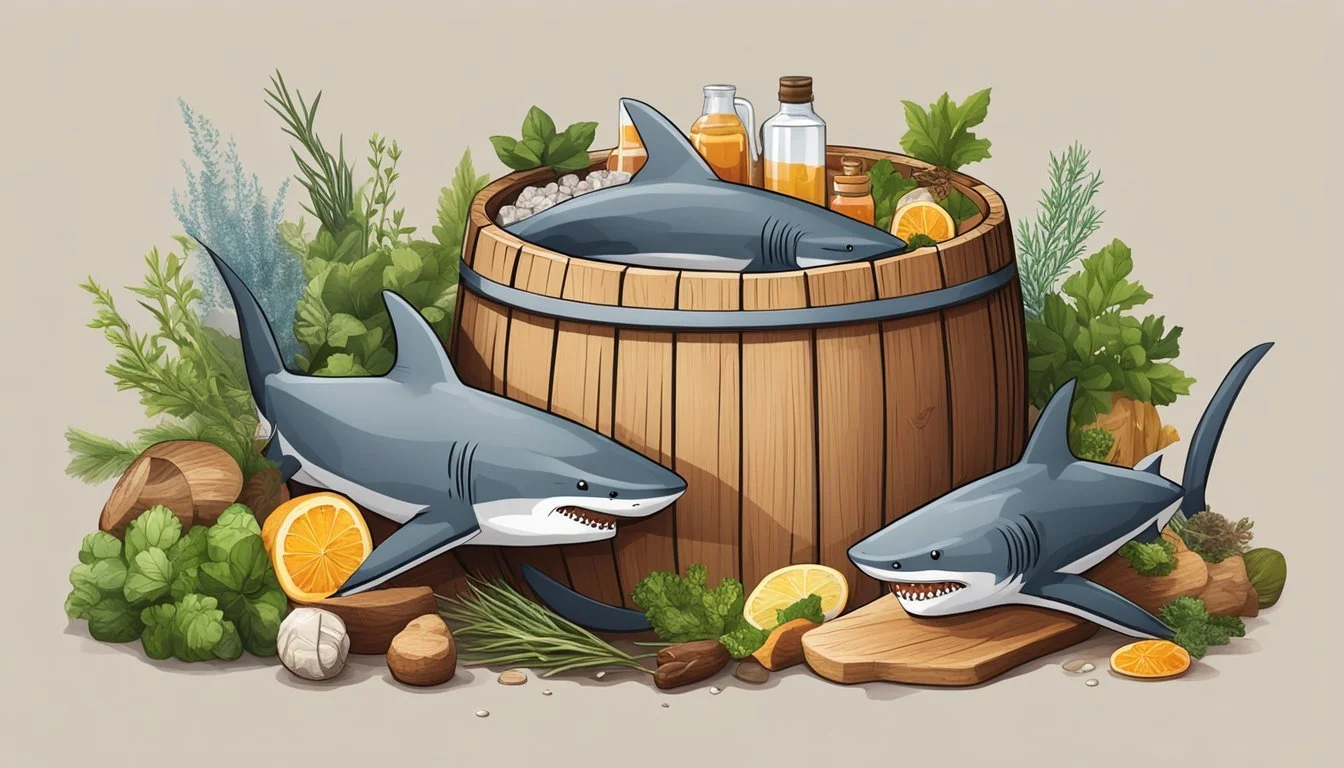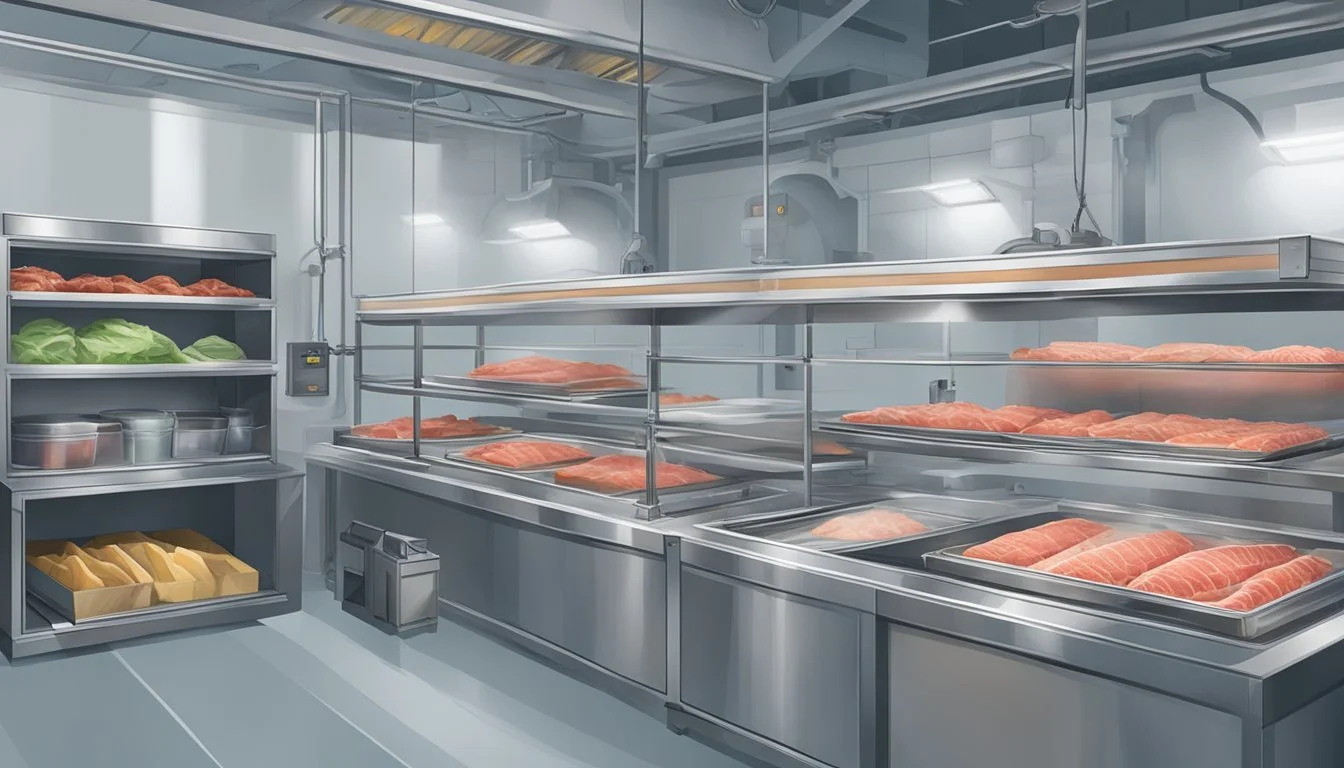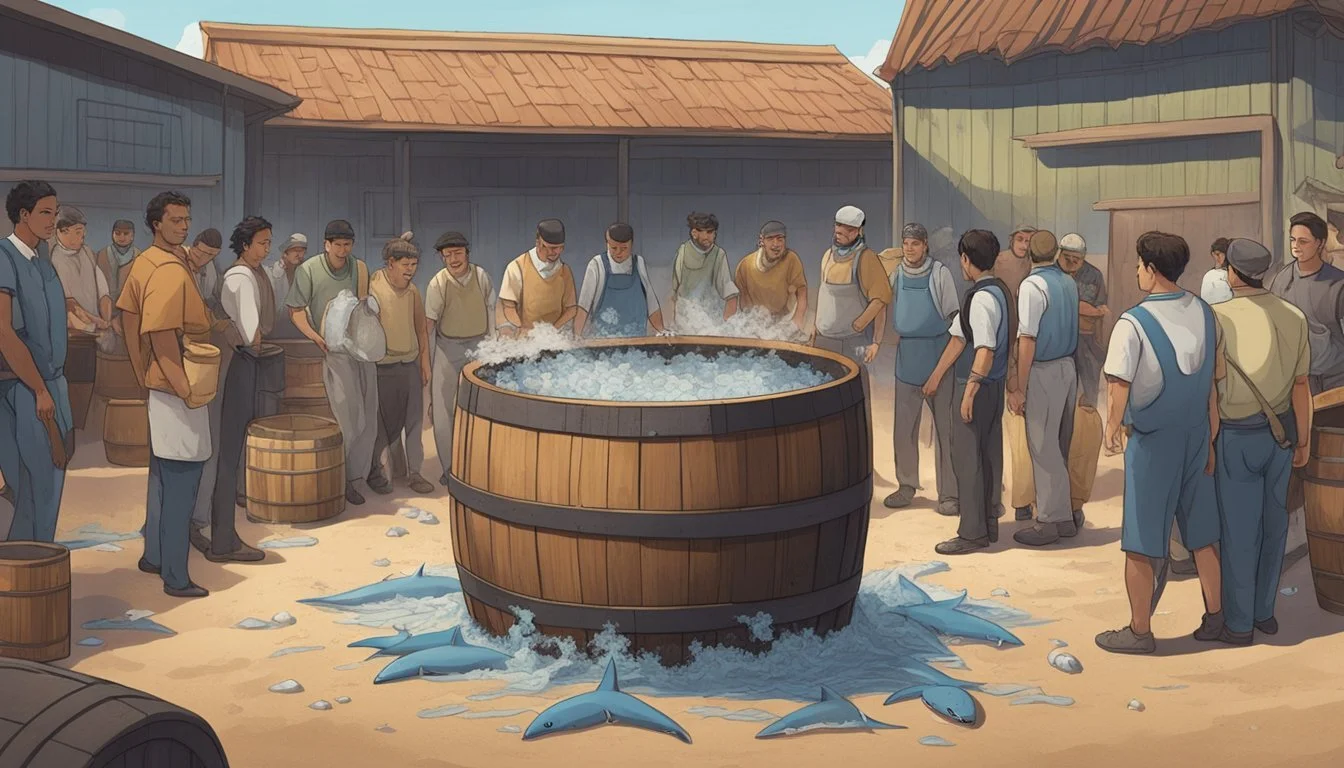How to Ferment Hákarl
Mastering Icelandic Shark Fermentation Techniques
Hákarl, the Icelandic fermented shark, is a traditional dish deeply ingrained in Iceland's culinary history. This unique food item, originating from the need to preserve meat in the harsh conditions of the North Atlantic, showcases Iceland's innovative preservation methods. Made primarily from Greenland or other sleeper sharks, which are naturally toxic due to a high content of urea and trimethylamine oxide, the fermentation process is essential to convert these toxins into non-toxic compounds and to impart the dish's distinctive flavor.
The preparation of hákarl involves a process of curing the shark's meat that allows it to ferment adequately before consumption. After catching, the shark is beheaded and gutted, and the meat is cut into strips. It is then placed in a shallow grave in porous, gravelly sand and covered with stones that apply pressure, aiding the process by allowing toxic fluids to seep out, a crucial step that lasts several weeks. Following the initial fermentation, the meat is hung to dry for a few months, during which it develops a strong ammonia-rich smell and a unique taste that has become a celebrated aspect of Icelandic gastronomy.
Despite its pungent aroma and potent flavor, hákarl holds a special place in the hearts of Icelanders and is often associated with the midwinter festival known as Þorrablót. Enjoying this dish is considered by many to be an homage to the resilience and resourcefulness of Iceland’s ancestors. Hákarl is not only emblematic of Iceland's tradition but also a testament to the island nation’s enduring connection to its past.
Historical Background
The historical context of hákarl is intricately tied to the legacy of Viking survival tactics and the evolving culinary traditions of Iceland, becoming an integral part of the national identity.
Viking Heritage and Origins
Viking Age: The tradition of fermenting shark meat to produce hákarl dates back to the Viking Age, characterized by the ingenuity of early Scandinavian explorers and settlers. These Vikings, facing the arduous and inhospitable conditions of early Iceland, devised a method of preserving shark meat out of sheer necessity.
Early Icelanders: They found that burying the toxic meat of the Greenland shark in the sand allowed for a fermentation process to occur, thereby neutralizing the toxins and rendering the meat edible. This process was essential for early Icelanders, who had to utilize every available resource to sustain themselves in a challenging environment.
Cultural Significance in Iceland
National Dish: Over the centuries, hákarl evolved from a survival technique to a celebrated national dish of Iceland.
National Identity and Historical Significance: The preservation method has remained relatively unchanged since Viking times, becoming a vital link to the past and a testament to Iceland's ability to adapt and persevere. The consumption of hákarl during traditional festivals, notably the midwinter festival of Þorrablót, underscores its cultural importance and connection to Icelandic identity.
The Hákarl Experience
The Hákarl Experience involves a sensory journey through its distinctive flavor, texture, and regional variations. Consuming Hákarl is not only about taste; it involves a cultural understanding and a readiness to embrace an unusual culinary tradition.
Flavor Profile
Hákarl possesses a strong flavor that is often described as an acquired taste due to its intense, ammonia-rich smell and peculiar aftertaste. The initial impression often elicits comparisons to rotten shark, underlining the uniqueness of its taste which has similarities with very strong cheese, such as blue cheese. Connoisseurs appreciate the depth and complexity Hákarl brings to the palate.
Textural Characteristics
The texture of Hákarl is decidedly rubbery, offering resistance to the bite. This chewy consistency adds to the overall sensory profile of the dish. The tactile feel of Hákarl varies slightly depending on preparation methods but typically retains its characteristic firmness that adds to its uniqueness.
Variations Across Iceland
Hákarl comes in various forms across Iceland, with glerhákarl (clear hákarl) and skyrhákarl (reddish hákarl) being the most notable. The former is cured for a shorter duration and has a milder taste, while the latter is fermented longer and boasts a more intense flavor. Both are traditionally served in small cubes accompanied by a shot of Icelandic spirit, emphasizing the local custom of balancing the potent taste with strong alcohol.
Preparation and Fermentation
Before delving into the unique culinary tradition of Hákarl, it is essential to understand the meticulous process of selection, fermentation, and drying. This method transforms the Greenland shark, a fish otherwise toxic to humans, into a celebrated Icelandic delicacy.
Selection of the Greenland Shark
The preparation of Hákarl begins with the careful selection of the Greenland shark, known also as the sleeper shark. This cold-water species contains high levels of urea and trimethylamine oxide in its flesh, which, through the fermentation process, are converted into ammonia, effectively neutralizing the toxins. It is crucial that the shark is properly gutted, with head and innards removed, to ensure sanitary conditions for the succeeding steps.
The Fermentation Process
Once the shark has been prepared, it undergoes the critical stage of fermentation. The flesh is initially buried in gravelly sand, allowing it to be weighted down by stones directly on top. This pressure expedites the seeping out of fluids, facilitating the development of beneficial bacteria for fermentation. This process typically lasts for 6-12 weeks depending on environmental factors, and is characterized by a breakdown of complex proteins, which turns the hazardous flesh edible.
Post-Fermentation and Drying
Following fermentation, the shark meat is taken from its gravel bed and hung to dry. This is commonly carried out in a well-ventilated, dry environment such as an open-air drying shed. During the drying process, which can range from several weeks to a few months, the meat forms a brown crust, signaling its readiness for consumption. At the end of this phase, it is cut into strips or cubes, ready to be sampled by those brave enough to experience its distinctive flavor profile.
Health and Safety Considerations
When fermenting hákarl, considerations for health and safety are paramount, due to the unique nature of the shark meat and its transformation into an edible product.
Toxicity and Treatment
The Greenland shark, from which hákarl is made, naturally contains high levels of urea and trimethylamine oxide, which are compounds that can be toxic to humans. During the fermentation process, these substances are broken down, ultimately making the shark meat safe for consumption. The traditional preservation technique involves a specific enzymatic process where the shark is buried in sand and gravel, pressed with stones to expel toxic fluids, and then hung to dry for several months. Through this method, urea is converted into ammonia, which plays a crucial role in the eventual reduction of toxicity.
Handling and Storage
Handling and storage of hákarl must be undertaken with safety protocols in mind to ensure resilience of the product and the health of the consumer. After fermentation, the hákarl should be stored at a cool temperature to preserve its protein integrity and prevent spoilage. It is necessary to store the hákarl in a well-ventilated area due to the strong ammonia smell that is a by-product of the fermentation. When handling hákarl, the use of protective gloves is recommended to avoid skin contact with the ammonia-rich meat, which can be irritating. Proper storage and handling are essential to maintain the survival of the delicacy's edible state and its cultural significance.
Societal and Economic Impact
The production and consumption of Hákarl plays a significant role in both societal customs and the economic framework of Iceland, influencing dining experiences, cultural festivals, and tourism.
Íslenski Barinn and Icelandic Dining
Restaurants like Íslenski Barinn have become cornerstones of the Icelandic dining scene by incorporating traditional dishes such as Hákarl into their menus. This Icelandic fermented fish is not just food but an integral part of culinary identity, often featured during national festivals like Þorrablót. Visitors frequent these establishments seeking an authentic taste of Icelandic cuisine, where Hákarl is presented as a delicacy. The shark museum, Bjarnarhöfn, where the Hákarl is prepared, also doubles as an educational attraction, introducing both locals and tourists to the traditional ways of fermenting Greenland shark.
Economic Aspects and Tourism
The economic impact of Hákarl is twofold: local Icelandic stores benefit from year-round sales as it is a national dish, and the tourism sector capitalizes on the intrigue surrounding this unique delicacy. Tourists add Hákarl tasting to their Iceland itineraries, often through structured food tours, enhancing the economic vitality of these experiences. The cost of Hákarl also contributes to its status; its complex preparation process justifies a premium price tag, making it a luxury item within the market. Furthermore, locations like the Bjarnarhöfn Shark Museum serve as both a hub for Hákarl production and a tourist destination, combining cultural education with economic activity.
Modern Consumption and Popularity
Hákarl, continues to be an emblem of Icelandic culinary heritage, intertwining tradition with modern-day consumption and media portrayal.
Contemporary Practices
Þorrablót festivals serve as a quintessential platform for the unique tradition of consuming Hákarl. These midwinter festivities highlight traditional Icelandic foods, where Hákarl stands out as a delicacy rather than a daily snack. It is often paired with Brennivín, an Icelandic schnapps nicknamed 'Black Death', which complements the strong taste of the fermented shark.
Þorrablót: Traditional midwinter festival
Hákarl: Served as a delicacy
Brennivín: Traditional Icelandic schnapps
The consumption of Hákarl today often bridges the past with the present, where locals might indulge out of a sense of nostalgia or cultural identity, while visitors are drawn to it seeking an authentic Icelandic experience.
Global Recognition Through Media
Internationally renowned chefs and food critics like Anthony Bourdain, Gordon Ramsay, Andrew Zimmern, Neil Oliver, and Richard Ayoade with Jessica Hynes have featured Hákarl in their travel and culinary shows. Their reactions, ranging from intrigued to downright appalled, have bolstered Hákarl's notorious reputation.
Anthony Bourdain: Referred to Hákarl as the "single worst, most disgusting and terrible tasting thing" he had ever eaten.
Gordon Ramsay: Demonstrated visible struggle while attempting to eat Hákarl.
Andrew Zimmern: Known for trying unusual foods, Zimmern also sampled this Icelandic specialty.
Richard Ayoade with Jessica Hynes: Featured Hákarl in the travel documentary series "Travel Man."
This exposure has served to both intrigue and challenge food enthusiasts around the globe, culminating in a somewhat notorious status that prompts the curious and brave to attempt a taste of this Icelandic phenomenon.
Pairings and Culinary Pairings
When enjoying Hákarl, selecting the right accompaniments can either heighten or balance its robust flavor. Traditional Icelandic pairings offer a nod to cultural heritage, while innovative combinations can introduce contemporary twists on the traditional taste.
Traditional Accompaniments
Brennivin: Traditionally, Hákarl is often paired with Brennivin, an Icelandic spirit also known as "Black Death." Its caraway flavor complements the strong taste of the fermented shark.
Þorramatur: A selection that may include Hákarl, along with other Icelandic delicacies such as hangikjöt (smoked lamb) and skyr (a thick yogurt-like dairy product).
Innovative Combinations
Innovation in Icelandic Cuisine:
Skyrhákarl: Modern chefs experiment by combining Hákarl with skyr to create a contrasting creamy texture and to mellow the shark’s sharpness.
Blue Cheese: For those who appreciate strong flavors, pairing Hákarl with blue cheese offers a similar pungent kick that some may find pleasing.
By embracing both the traditional and the innovative, Hákarl enthusiasts can enjoy a range of culinary experiences that honor the past while looking forward to new taste horizons.
Culinary Influence and Future
The future of Hákarl intertwines with its sustained impact on Icelandic culture and the potential for innovation within traditional practices.
Influence on Icelandic Cuisine
Hákarl, or kæstur hákarl (fermented shark meat), is not only an Icelandic delicacy but also a food that is deeply embedded in the cultural heritage of Iceland. It carries substantial cultural significance, originating from the time of the Vikings, and has continually influenced Icelandic cuisine. As a symbol of survival and ingenuity, Hákarl demonstrates the resourcefulness of Icelanders in using what could be considered waste—shark meat that is otherwise inedible due to its high urea content—and transforming it into a nutritious item through fermentation.
The dish is primarily served during traditional Icelandic festivals such as Þorrablót, showcasing its continued relevance in Icelandic society. Despite its notorious reputation among the uninitiated for its strong aroma and taste, it remains a testament to the nation's culinary history and the Icelandic tradition of valuing every part of an animal.
Future of Hákarl
Looking toward the future, Hákarl stands at a crossroads of tradition and innovation. As international palates become increasingly adventurous, there is potential for the fermented shark to gain popularity akin to that of surströmming, another fermented seafood delicacy from Sweden. Innovations in food processing and greater focus on sustainable practices could potentially alter the traditional fermentation process of Hákarl, possibly even enhancing its nutritional value and reducing its notoriously potent odor, which might make it more palatable to a broader audience.
However, any changes to the fermentation process would need to balance modernity with the maintenance of cultural authenticity that is so vital to its role in Iceland's gastronomic heritage. As the world becomes more connected and interested in unique foods, Hákarl could see a rise in demand—if its production can be scaled in a way that stays true to Icelandic traditions and continues to reflect the nation's historical resilience.





